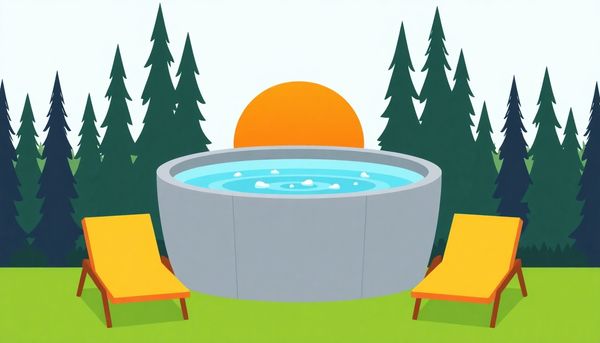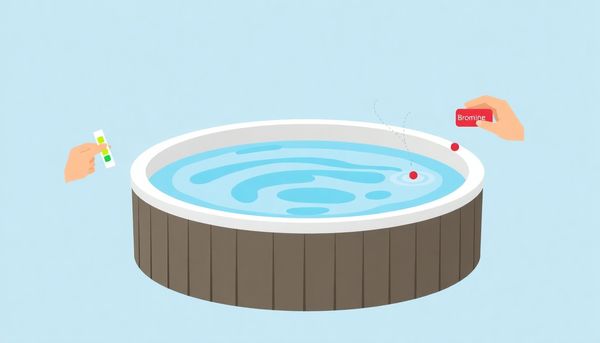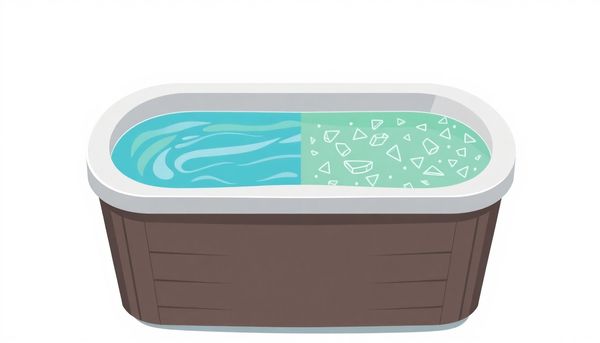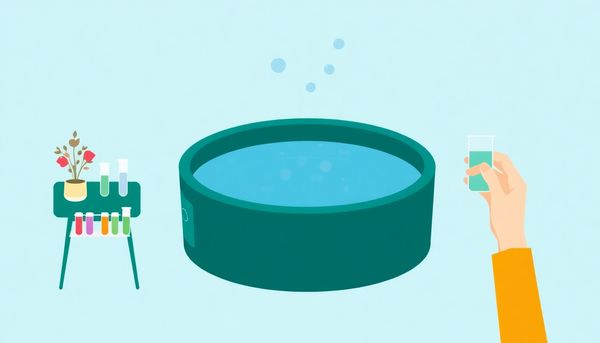Master Hot Tub Chemistry: Essential Tips for Safe Soaking
November 20th, 2024
November 20th, 2024
Balancing hot tub chemistry might not be everyone’s idea of a weekend delight, but it’s a crucial routine for anyone who cherishes their steamy oasis. When I first became the proud owner of a hot tub, I naively thought the process involved nothing more than occasionally skimming the surface and topping up the water. A friend soon rescued me from my blissful ignorance, introducing me to the alchemy that ensures each soak is both relaxing and safe.
Understanding the science behind hot tub chemistry transforms maintenance from a chore into an empowering ritual. Each chemical plays a unique role, from sanitizers that banish harmful bacteria to pH balancers that keep your skin feeling smooth. The murky waters of imbalanced chemistry can lead to anything from skin irritation to costly equipment damage. Therefore, knowing what to add and when is not just advisable—it’s essential.
Many hot tub novices, like myself once, often overlook the importance of testing as frequently as using the tub itself. Test strips are simple yet powerful tools that guide your chemical choices. With a quick dip into the water, these strips provide invaluable insights into your tub’s current state. Whether the results indicate a need for more sanitizer or a pH adjustment, being proactive keeps your tub experience enjoyable and hassle-free. So, as we embark on this journey through hot tub chemistry, let’s unlock the secrets that transform a bubbling bath into a sanctuary of comfort and wellness.

So, you've just invested in a hot tub, and now you're the proud owner of a bubbling oasis. But wait—how do you keep that water pristine and inviting? Enter the world of hot-tub sanitation, where the right chemicals are your best allies against murky disasters and unwanted guests of the microbial kind.
A few years back, I found myself tangled in the same web of confusion. My hot tub was more like a chemistry experiment gone wrong than a relaxing retreat. But soon, I cracked the code, and you can too. It begins with understanding the primary sanitizers: chlorine and bromine. Chlorine is quick, efficient, and widely used, but it's the bromine that steals the show with its gentle touch and ability to maintain effectiveness even as a byproduct called bromamines forms. For those looking for alternatives, mineral sanitizers and saltwater systems offer gentler, albeit slightly different, approaches.
Adding chemicals requires precision. Start with testing your water—often—and keep those test strips handy. Adjust alkalinity first, then pH, ensuring they're perfectly in sync to allow your sanitizer to work efficiently. My go-to trick? Always measure out your chemicals before adding them to avoid the risk of overdoing it. A few minutes spent this way can save hours of balancing woes later on.
By mastering these steps, you'll not only safeguard your hot tub but also ensure every soak is as luxurious as the first. Your hot tub paradise awaits, crystal clear and ready for relaxation.
A hot tub, though a perfect relaxation haven, requires more than just a quick scrub to maintain. Imagine lounging in what you believe is pristine water, only to realize its chemical balance is off. Navigating the world of hot tub chemistry ensures that your spa remains a safe and inviting retreat.
First and foremost, proper chemical balance begins with regular testing. Whether you prefer test strips or a liquid test kit, frequent checks prevent unwanted surprises. Once you have your readings, maintain a chlorine level between 1 to 3 ppm or a bromine level of 3 to 5 ppm, depending on your sanitizer of choice. These levels are your frontline defense against bacteria and algae.
But what about pH and alkalinity? These aren't merely numbers on a test strip. They influence how effectively sanitizers work. Aim for a pH between 7.4 and 7.6 to avoid both scaling and corrosion. An alkalinity level of 100 to 150 ppm will stabilize pH fluctuations, making it easier to maintain a consistent, healthy environment.
Finally, remember that calcium hardness is more than a fancy term. A balance of 175 to 250 ppm prevents equipment damage from both excessive softness and hardness. With these measures in place, your hot tub's chemical harmony will transform it into more than just a tub—it's a sanctuary of relaxation, primed and ready whenever you are.
Navigating the world of hot tub sanitizers can feel like choosing between a dazzling array of flavors at an ice cream parlor. Each option promises a different kind of experience, and picking the right one can make all the difference. You’ve probably heard of chlorine and bromine—two stalwarts in the sanitization squad.
Chlorine is like the universal soldier, capable of tackling bacteria, fungi, and viruses effectively. It’s affordable and accessible, though it’s known for its distinctive odor, a byproduct of its battle with contaminants. If the scent of chlorine is overpowering, it’s a clue that your levels are off-kilter, not a sign of cleanliness.
Bromine, on the other hand, is the softer-spoken cousin. It doesn’t have chlorine’s pungency, making it a favorite for indoor hot tubs. It’s a bit slower on the uptake but more resilient in doing its job quietly over time. For those sensitive to odors, it’s a serene choice, though it might not fare well under the sun’s relentless gaze.
Then there’s the sleek option: biguanide. While it avoids the pitfalls of chlorine and bromine, it tends to be pricier and might not play nicely with all spa components. Ensuring compatibility with your hot tub is crucial before diving in.
In essence, your choice boils down to personal preference and your hot tub’s environment. Whether it’s the robust efficiency of chlorine, the gentle persistence of bromine, or the modern appeal of biguanide, understanding each option helps you cultivate a relaxing oasis that suits your needs.
Implementing consistent cleaning practices is like nurturing a friendship—it requires regular attention and care to thrive. One might think of a hot tub as a self-sustaining oasis, but without a diligent maintenance routine, it soon becomes a breeding ground for unwelcome guests like bacteria and algae. Imagine sitting around with friends, enjoying a soak only to notice the water's a bit off. A routine clean-up schedule ensures this is a scenario you’ll never have to experience.
Start by establishing a weekly regimen that includes skimming the surface for leaves and debris, scrubbing the shell to prevent biofilm build-up, and cleaning the filters to maintain optimal flow and sanitation. You remember that time when your hot tub started to smell a bit funky? Regular filter maintenance could have prevented that, allowing the sanitizers to work effectively without interference.
Don’t forget to shock your hot tub weekly or after heavy use. This recharges the sanitizer, giving it the strength to combat contaminants that have snuck in during that last hot tub party. Consider the shock as a mini reset button for your water chemistry. With consistent cleaning, not only do you extend the life of your hot tub, but you also carve out a perfect sanctuary that’s always ready to offer relaxation and comfort. The more you care for your tub, the better it takes care of you, providing a crystal-clear escape every time you slip into its warm embrace.

Choosing the right sanitizer is akin to selecting the foundation of a sturdy house—get it right, and everything else falls into place. When it comes to hot tubs, not all sanitizers are created equal. Each one carries its own set of advantages and quirks, much like different breeds of dogs. Some prefer the classic route with chlorine, a reliable soldier in the battle against bacteria. It's effective, but beware the infamous chloramine odor that can emerge when it's working overtime.
On the other hand, bromine steps in as a quieter contender, less pungent and more stable in warm water, making it a favorite for those who soak frequently. Yet, it’s not without its drawbacks; bromine can be pricier and may sluggishly combat contaminants compared to its chlorine counterpart.
Then there's biguanide, the unconventional choice. Often marketed under brand names, it eschews the typical chlorine and bromine pathways and instead offers a different chemical approach to bacteria busting. However, it's crucial to ensure compatibility with your hot tub's materials, as it can be a tad harsh on certain plastics.
For those who like to keep things minimalistic, mineral sanitizers present a natural alternative. Utilizing silver or copper, these systems can reduce chlorine dependence, although they can't completely replace it. Each choice has its unique role, so weigh your options and align them with your priorities for a sparkling, inviting hot tub experience.
Choosing the right sanitizer is akin to picking the perfect outfit for an important occasion—it sets the stage for everything else. In the realm of hot tub maintenance, this decision determines not only how clean your water stays but also the comfort and overall experience of a soak. There are several effective sanitizers, each with its own set of traits and quirks.
Chlorine is the classic go-to for many, praised for its powerful bacteria-killing capabilities. It's a bit like that reliable friend who's always there when things get tough. However, chlorine does come with its distinct aroma, often misunderstood. The smell isn’t actually from the chlorine but from chloramines, which occur when chlorine breaks down contaminants. It’s a signal that your water needs more, not less, of this sanitizer.
For those less fond of chlorine's olfactory footprint, bromine offers a subtler alternative. This gentler cousin works slower but is less apt to leave a lingering scent. Ideal for indoor hot tubs, bromine maintains its integrity even without stabilizers.
Biguanide, known by brand names like BaquaSpa, is another option, revered for its non-chlorine approach and gentle touch on sensitive skin. Yet, it’s a pricier choice and might not play nice with all spa components.
For a more eco-friendly angle, mineral sanitizers, often combining silver and copper, reduce chlorine use but cannot eliminate it entirely. And let's not overlook salt water systems, which transform salt into chlorine for a softer water experience.
Ultimately, the right sanitizer is one that aligns with your personal priorities, whether that's ease of use, cost-effectiveness, or minimizing chemical exposure. Make your choice wisely, and your hot tub will thank you with clarity and peace.
Balancing chemicals in a hot tub might sound as daunting as a chemistry class, but it's more like following a recipe—once you know the ingredients and the process, it becomes second nature. First, you'll want to get cozy with your testing kit. Test strips or liquid kits are your best allies; they reveal the secrets of your water's pH, alkalinity, and sanitizer levels. Think of them as the foundation for a safe and enjoyable soak.
Imagine the water in your hot tub like an ecosystem that needs balance to thrive. Elements such as chlorine and bromine are crucial, acting as gatekeepers to keep unwanted organisms at bay. But it’s not just about dumping them in and hoping for the best. Precision is key. After testing, you'll determine exactly how much of each chemical to add, ensuring that levels are neither too high nor too low—a bit like seasoning a dish to perfection.
Throughout my years of hot tub ownership, I've learned that consistency is your friend. Regularly monitoring and adjusting chemical levels prevents a cascade of issues, from murky water to irritated skin. If you ever find yourself in doubt, remember that advice from professionals at a local spa store is invaluable. They can help decode water test results and guide you toward achieving that perfect chemical harmony. By maintaining these levels, you safeguard your investment and ensure every dip is as refreshing as the last.
Testing your hot tub water may not seem like a thrilling task, but it is the linchpin of maintaining an inviting, safe spa environment. Just as you might routinely check your car's oil, keeping an eye on your hot tub’s chemistry ensures everything runs smoothly. Unlike a quick dip in the pool, a soak in the hot tub involves prolonged exposure, so balanced water is crucial for both comfort and safety.
Consider it a routine part of your hot tub ritual. Each week, or more frequently if the tub sees a lot of action, take a moment to use test strips or a liquid test kit to gauge the levels of key chemicals. These tools help you monitor pH, alkalinity, and sanitizer levels—three critical measurements that dictate the overall health of your water. For those not keen on DIY testing, local pool and spa stores offer professional testing services.
Once you have the readings in hand, adjustments become straightforward. This proactive approach not only prevents potential water issues but also extends the lifespan of your equipment. Remember, clear and balanced water isn’t just about cleanliness; it’s about enhancing your overall hot tub experience. Keep your supplies well-stocked, make testing a habit, and enjoy the peace of mind that comes with knowing your hot tub is always ready for a soothing soak.

When it comes to maintaining a hot tub that invites relaxation rather than frustration, understanding the balance between alkalinity and pH is crucial. Think of alkalinity as the steady hand guiding your pH levels, preventing them from swinging wildly and causing trouble. When alkalinity is balanced, it acts as a buffer, keeping the pH in check.
Some years ago, I learned this the hard way. After a weekend getaway, I returned to find my hot tub water looking like cloudy soup. A quick check with my trusty test strips revealed the issue: low alkalinity had allowed the pH to plummet, turning the water acidic enough to cause minor damage to the hot tub's surface. I quickly added an alkalinity increaser, a staple in my spa cabinet since that day, and brought the pH back to a safe level.
On the flip side, if alkalinity strays too high, you'll notice pH stubbornly following along. Unlike a dedicated alkalinity decreaser, you'll need a pH decreaser to adjust both levels down. This interdependence can be tricky, but mastering it ensures your hot tub remains a haven of comfort, not a chemistry conundrum. Proper alkalinity should sit between 100 to 150 parts per million (ppm), while pH should rest comfortably at 7.4 to 7.6. Keep these levels in mind, along with regular testing, to ensure a smooth soak every time.
Testing and adjusting the alkalinity of your hot tub is like finding the sweet spot for a perfectly brewed cup of coffee. Too high or too low, and the experience isn't quite right. Alkalinity acts as the stabilizing backbone of your hot tub water, ensuring that changes in pH don’t occur too rapidly. Without the correct balance, you might find yourself bathing in water that's either too acidic or too basic, which isn't just uncomfortable—it can be damaging to both your skin and your tub.
Grab those test strips or a reliable liquid test kit. Testing regularly helps you pinpoint exactly what your water needs. For instance, if your alkalinity reads below 100 ppm, the water can lean towards being acidic, leading to corrosion of your hot tub's parts. Conversely, if it’s above 150 ppm, the water becomes too hard, causing scaling and making it difficult for sanitizers to work effectively.
Once you know the alkalinity level, adjust using an alkalinity increaser if it’s too low. If it’s too high, a pH decreaser can bring it down. It's a bit of a dance between alkalinity and pH, each affecting the other. Trust me, the time spent getting this balance right is worth it. Your hot tub will reward you with clearer water and a longer lifespan. This is one chemical chore where precision pays off in relaxation dividends.
Selecting the ideal sanitizer for your hot tub is akin to choosing the right teammate for a crucial game—each option comes with its unique strengths and a few limitations. You'll want to start with what is most common and familiar: chlorine. Its reliability stems from its ability to oxidize and eliminate harmful organisms efficiently. However, the infamous "chlorine smell" isn't actually from the chlorine itself, but from chloramines—a byproduct of chlorine doing its job. A quick water test can determine if a shock treatment is needed to clear these out and refresh your soak.
Bromine, the mild-mannered alternative, doesn't produce those pesky chloramines. Instead, it ionizes contaminants, making it a choice favorite for indoor hot tubs or those away from constant sunlight. Though it works slower than chlorine, bromine maintains a longer-lasting protective presence. Just remember, it falters under direct sunlight due to its lack of a stabilizing agent.
For those seeking a break from traditional chemicals, consider biguanide or mineral sanitizers like silver and copper. Biguanide offers chlorine-free purification but may impact some hot tub parts. Meanwhile, minerals can reduce chlorine usage but still require its presence for full effectiveness. Each option, while offering distinct advantages, demands careful consideration of your tub's environment and maintenance routine.
Ultimately, your choice depends on your lifestyle, usage, and preferences. Familiarize yourself with these sanitizers, and you'll find maintaining a pristine hot tub becomes an effortless delight.
In the world of hot tub maintenance, mineral sanitizers offer a whisper of nature's elegance amidst modern solutions. Picture the gentle touch of silver and copper, two ancient elements synergizing to enhance your spa experience. While silver is celebrated for its bactericidal prowess and copper for its ability to fend off algae, together they form the backbone of a mineral sanitizer system. This option is perfect for those who wish to reduce the chemical load on their skin, as mineral sanitizers allow for significantly reduced chlorine use. Simply a sprinkle of these minerals can soothe your skin while still effectively maintaining water clarity.
Here's how it works: mineral sanitizer sticks are designed for simplicity and ease. Insert one into your hot tub's filter, and it will release the minerals gradually over several months. This hands-off approach is particularly appealing for busy individuals who appreciate low-maintenance solutions. However, remember, minerals alone aren’t a complete solution. Complementing them with a minimal amount of chlorine ensures your hot tub remains free from unwanted guests, such as bacteria and algae.
Despite their ease and skin-friendly nature, mineral sanitizers are also budget-friendly, adding economic value to their list of merits. Imagine basking in the soothing embrace of your hot tub, knowing you've harnessed the power of nature without compromising on cleanliness or safety. Whether you’re a hot tub newbie or a seasoned spa enthusiast, consider giving mineral sanitizers a try; they might just become your favorite chemical companion.

Calcium hardness might not be the first thing you think of when maintaining your hot tub, but it's as essential as any other chemical balance. Consider calcium hardness as the silent guardian of your spa's infrastructure. Low calcium levels can lead to corrosive water, which might sound like something out of a sci-fi movie but is quite a real threat to your hot tub’s shell and plumbing. Over time, the water can eat away at these materials, leading to costly repairs or replacements.
On the other hand, a surplus of calcium isn't your friend either. Excessive calcium results in hard water, which can create scaling on your equipment and cloud your water, giving your hot tub an uninviting appearance. If you’ve ever dealt with stubborn lime deposits on a faucet, you’ll know the frustration of trying to clean scale off your spa.
To manage this balance, regularly test the calcium hardness and aim for levels between 175 and 250 ppm. If your levels fall short, add a calcium hardness increaser, but if they soar too high, sometimes starting fresh by draining and refilling your tub can be the best solution. Keeping calcium hardness in check ensures your hot tub remains an oasis of relaxation rather than a battleground of chemical warfare.
Testing the water in your hot tub might sound like a minor chore, but it's a crucial step in maintaining a pristine soak. Think of it as routine health checks for your spa, ensuring everything is in top-notch condition. A simple habit, yet it yields significant rewards.
Every week, or more often if you’re an enthusiastic bather, grab those trusty test strips or invest in a liquid test kit for pinpoint precision. They’re your best friends when it comes to keeping alkalinity, pH, and sanitizer levels in check. Skipping this step? You might find yourself in the murky waters of irritation, equipment damage, or worse—an unsanitary hot tub experience.
There’s also peace of mind in numbers. Armed with readings, you can make informed decisions about which chemicals to add and how much is just right. It’s not unlike following a recipe; too much or too little can spoil the soup.
Consider a recent weekend when I noticed a slight cloudiness in my tub. A quick test revealed unexpected pH levels. A small adjustment later, and my hot tub was sparkling again, ready for relaxation. It’s these regular check-ins that transform hot tub maintenance from a daunting task into a simple, manageable routine. So, keep those testing tools close, and let your hot tub remain a haven of clarity and comfort.
Choosing an effective sanitizer for your hot tub isn't just about keeping the water clear; it's about ensuring a safe and enjoyable soak for everyone. Depending on your personal preferences and setup, several options are available, each with its own benefits and drawbacks.
Chlorine is the go-to for many due to its affordability and efficacy. Like a trusty old friend, it's been around forever, taking down bacteria and fungi with practiced ease. However, if you've ever winced at that sharp, familiar smell, you've encountered chloramines, a byproduct of chlorine doing its job. Proper levels (1-3 ppm) help to keep this in check.
Bromine offers a quieter approach, particularly suited for indoor or shaded tubs. It doesn't oxidize like chlorine, which means no chloramines, and thus, no smell. This makes it a popular choice for those sensitive to chemical odors. However, bromine’s slower action means contaminants have a bit more time to linger before being neutralized.
Biguanide and mineral sanitizers provide alternatives for those looking to avoid traditional chemicals. Biguanide, though effective, can be a bit spendy and may not play nice with all spa components. Mineral systems, meanwhile, need a little chlorine to truly shine but offer a gentler approach on skin and hair.
Regardless of your choice, ensuring the right levels and regular maintenance is key. The right sanitizer not only protects your health but also extends the life of your hot tub, making every soak a pleasant experience.
Balancing calcium levels in your hot tub is like fine-tuning a musical instrument—while subtle, it's crucial for harmony. Calcium hardness, the unsung hero of hot tub chemistry, demands attention to keep both your skin and equipment happy. High calcium levels might seem innocuous, but they can lead to unsightly scaling on surfaces and clog your filters, much like that stubborn limescale on kitchen taps.
On the flip side, if calcium levels fall too low, expect corrosion and etching on your tub's interior. This might make you think of a friend's antique car, gleaming on the outside but rusted underneath. To avoid such hidden damage, a calcium hardness increaser is your trusty sidekick. Adding it judiciously ensures the calcium levels hover between 175 and 250 ppm, a sweet spot preventing both scaling and corrosion.
One weekend, I found my hot tub's calcium levels plummeting after a heavy rain. A quick check with a test strip and a dash of calcium increaser set things right, saving me from an impromptu chemistry experiment gone awry. So, keep those test strips handy and check regularly; that way, you're always ready to tweak and maintain that perfect calcium balance, ensuring your hot tub remains a sanctuary rather than a repair project.

"Use Testing Kits Effectively"
Navigating the world of hot tub maintenance feels daunting at first, but mastering the basics makes it manageable. A key player in this endeavor? The humble testing kit. It's your best friend in maintaining a safe, crystal-clear soak. Unlike a mere glance, these kits offer an accurate snapshot of your water's health. Both test strips and liquid kits are available to suit your preference – either option will guide you in determining what adjustments your water requires.
Imagine unboxing a testing kit for the first time. You dip a strip into the water or add drops to a test vial, and like magic, colors appear. These colors are your water’s way of communicating its needs. If you’re using strips, compare them against the chart provided. With liquid kits, follow each step meticulously to ensure precise results.
Routine testing is crucial. Ideally, test your hot tub water twice a week. This consistent schedule allows you to catch imbalances before they escalate. Let’s say you test your water and notice that the pH level is creeping up. Addressing it promptly keeps the water comfortable, preventing irritations and equipment damage. Plus, regular testing becomes second nature, much like checking your phone battery.
For those moments when a second opinion is needed, many local pool and spa stores offer water testing services. They provide detailed analyses and recommendations, adding an extra layer of assurance. Remember, the more familiar you are with your water's chemistry, the better you can tailor the care it needs.
Navigating the world of hot tub sanitizers can feel akin to choosing between various spices in a recipe—each offering a unique flavor to your soaking experience. Yet, unlike culinary experiments, opting for the right sanitizer is crucial for both hygiene and enjoyment. Chlorine stands out as a popular choice due to its robust ability to eliminate bacteria, fungi, and viruses. Reminiscent of bleach, it swiftly handles contaminants, although some might find its resulting chloramine odor a bit overpowering. If you're like a friend of mine who insists on a scent-free relaxation zone, bromine might be your ally. Operating quietly through ionization, it’s effective without the strong smell, though it works a tad slower than chlorine.
For those seeking a gentler approach, biguanide beckons. It’s gentle on the skin but can be harsh on the wallet and certain hot tub parts—like rubber gaskets—so a quick chat with your tub's manufacturer is wise. Meanwhile, mineral sanitizers offer a nuanced blend of silver and copper, reducing chlorine use while still requiring a touch of it.
Exploring these options reveals not just choices but also a deeper understanding of how each sanitizer can transform your hot tub experience. Whether prioritizing efficiency, gentleness, or cost, the right sanitizer enriches both the comfort and cleanliness of your aquatic haven, ensuring each soak is as refreshing as the last.
Navigating the world of hot tub chemistry can feel like deciphering a secret code, but let's break it down together, starting with measuring and adding the right chemicals. Imagine you're baking a cake; you wouldn't just toss in a handful of flour and hope it turns out delicious. The same principle applies to your hot tub. Each chemical serves a specific purpose and requires precise measurement to maintain water quality and equipment longevity.
First, gather your tools. A reliable set of test strips or a liquid test kit is essential. They’re akin to your measuring cups in the hot tub kitchen, giving you accurate readings of alkalinity, pH, and sanitizer levels. Once the water’s needs are diagnosed, consult the instructions on each chemical’s packaging—this will guide you in measuring the exact amount necessary to bring your levels into balance.
When it’s time to add chemicals, think of it as gently stirring ingredients into your mixture. With the jets running on low and air valves closed, sprinkle or pour the chemicals slowly into the water. This method ensures even distribution without splashing out of the tub, like folding flour into batter instead of whipping it aggressively. Allow the water to circulate for at least 20 minutes, letting the chemicals blend in seamlessly.
Finally, patience is your best friend. Retesting the water ensures balance is achieved before you take a dip. By staying attentive and precise, you transform your hot tub from just another backyard feature into a sparkling oasis, ready for relaxation and enjoyment.

This article provided insights into maintaining your pool. Start your pool care journey today!
Want to become a pool maintenance expert? Our free Pool School course covers everything you need to know about pool care. From basic maintenance to advanced troubleshooting, you'll learn how to:
Join over 10,000 pool owners who have already transformed their pool care routine. Get started with our free Pool School course today!